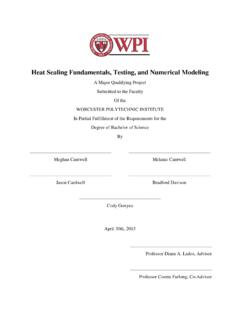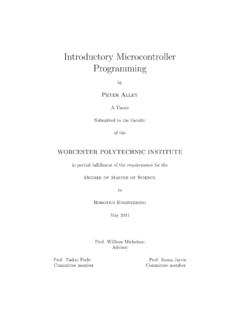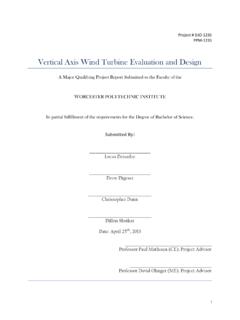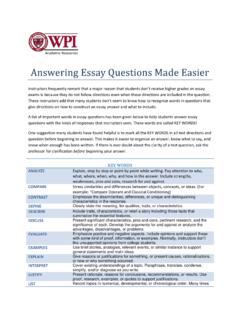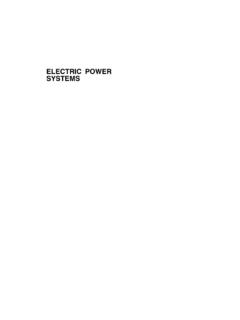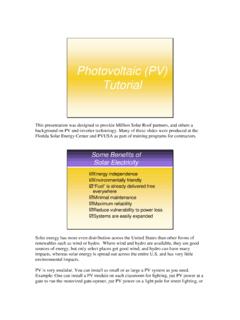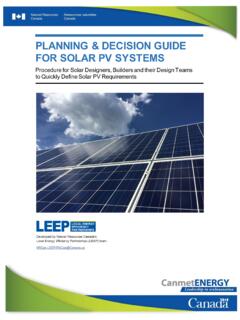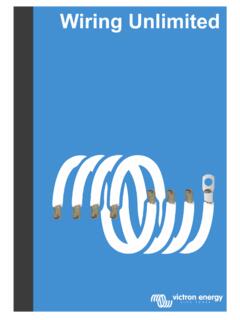Transcription of DC/AC Pure Sine Wave Inverter
1 N E C A M S I D. DC/AC Pure Sine Wave Inverter Jim Doucet Dan Eggleston Jeremy Shaw MQP Terms A B C 2006 2007. Advisor: Professor Stephen J. Bitar Sponsor: NECAMSID. Table of Contents ..1. Problem ..3. Inverters and Pulse Width Bubba H Bridge MOSFET Circuit Protection and Sine Wave Carrier Wave Pulse Width H ..30. Implementing the Sine Wave Filter .35. Putting the Design to ..38..40..44. Appendix A: Switching Frequency Appendix B: Circuit Appendix C: Appendix D: PCB Board Appendix E: Parts Index of Figures Commercial 200 Watt Square, Modified, and Pure Sine Pulse Width Bubba Oscillator RC Filter Signal at ..11. H Bridge Configuration using N Channel N Channel Inductive Load Inductive Load Circuit with Inductive Load Circuit with Snubber and Zener Block Bubba Oscillator Oscillator Signal at.
2 19. Oscillator Signal at ..19. Triangle Wave Square Wave Generated Triangle Square and Triangle PWM ..24. Sine Reference, Triangle Wave, and square wave Modified triangle wave, overlaid with sine PWM signal and reference Trilevel PWM H Bridge with MOSFET Typical Connection for IR2110 MOSFET Frequency plot of ..30. New Sine Wave Oscillator Circuit Two Pole Output Project on PCB Closed Loop Flow Non Inverting Amplifier Frequency plot of MOSFET Frequency plot of inductor losses (resistive)..41. Introduction This report focuses on DC to AC power inverters, which aim to efficiently transform a DC power source to a high voltage AC source, similar to power that would be available at an electrical wall outlet. Inverters are used for many applications, as in situations where low voltage DC sources such as batteries, solar panels or fuel cells must be converted so that devices canrun off of AC power.
3 One example of such a situation would be converting electrical power from a car battery to run a laptop, TV or cell phone. The method in which the low voltage DC power is inverted, is completed in two steps. The first being the conversion of the low voltage DC power to a high voltage DC source, and the second step being the conversion of the high DC source to an AC waveform using pulse width modulation. Another method to complete the desired outcome would be to first convert the low voltage DC power to AC, and then use a transformer to boost the voltage to 120 volts. This project focused on the first method described and specifically the transformation of a high voltage DC source into an AC output. Of the different DC AC inverters on the market today there are essentially two different forms of AC.
4 1. output generated: modified sine wave, and pure sine wave . A modified sine wave can be seen as more of a square wave than a sine wave; it passes the high DCvoltage for specified amounts of time so that the average power and rms voltage are the same as if it were a sine wave. These types of inverters are much cheaper than pure sine wave inverters and therefore are attractive alternatives. Pure sine wave inverters, on the other hand, produce a sine wave output identical to the power coming out of an electrical outlet. These devices are able to run more sensitive devices that a modified sine wave may cause damage to such as: laser printers, laptop computers, power tools, digital clocks and medical equipment. This form of AC power also reduces audible noise in devices such as fluorescent lights and runs inductive loads, like motors, faster and quieter due to the low harmonic distortion.
5 1 ABS Alaskan 1. Problem Statement In the market of power inverters, there are many choices. They range from the very expensive to the very inexpensive, with varying degrees of quality, efficiency, and power output capability along the way. High quality combined with high efficiency exists, though it is often at a high monetary cost. For 2. example, Samlex America manufactures a 600 W, pure sine wave Inverter ; the cost is $289 . Meanwhile GoPower manufactures a 600 W Inverter with a modified sine wave output (closer to a square wave); this 3. model only fetches $69 . The high end pure sine wave inverters tend to incorporate very expensive, high power capable digital components. The modified sine wave units can be very efficient, as there is not much processing being performed on the output waveform, but this results in a waveform with a high number of harmonics, which can affect sensitive equipment such as medical monitors.
6 Many of the very cheap devices output a square wave, perhaps a slightly modified square wave, with the proper RMS. voltage, and close to the right frequency. Our goal is to fill a niche which seems to be lacking in the power inverters market, one for a fairly efficient, inexpensive Inverter with a pure sine wave output. Utilizing PWM and analog components, the output will be a clean sinusoid, with very little switching noise, combined with the inexpensive manufacturing that comes with an analog approach. 2 600 Watt Pure Sine Wave Inverter . 3 Go Power 600 Watt Modified Wave Inverter 2. Background DC and AC Current In the world today there are currently two forms of electricaltransmission, Direct Current (DC) and Alternating Current (AC), each with its own advantages and disadvantages.
7 DC power is simply the application of a steady constant voltage across a circuit resulting in a constant current. A battery is the most common source of DC transmission as current flows from one end of a circuit to the other. Most digital circuitry today is run off of DC power as it carries the ability to provide either a constant high or constant low voltage, enabling digital logic to process code executions. Historically, electricity was first commercially transmitted by Thomas Edison, and was a DC power line. However, this electricity was low voltage, due to the inability to step up DC voltage at the time, and thus it was not capable of 4. transmitting power over long distances . V =IR. (1). P=IV = I 2 R. As can be seen in the equations above, power loss can be derived from the electrical current squared and the resistance of a transmission line.
8 When the voltage is increased, the current decreases and concurrently the power loss decreases exponentially; therefore high voltage transmission reduces power loss. For this reasoning electricity was generated at power stations and delivered to homes and businesses through AC power. Alternating current, unlike DC, oscillates between two voltage values at a specified frequency, and its ever changing current and voltage makes it easy to step up or down the voltage. For high voltage and long distance transmission situations all that is needed to step up or down the voltage is a transformer. Developed in 1886 by William Stanley Jr., the transformer made long 5. distance electrical transmission using AC power possible . 4 Charpentier 5 Bellis 3. Electrical transmission has therefore been mainly based upon AC power, supplying most American homes with a 120 volt AC source.
9 It should be noted that since 1954 there have been many high voltage DC transmission systems implemented around the globe with the advent of DC/DC. 6. converters, allowing the easy stepping up and down of DC voltages . Like DC power, there exist many devices such as power tools, radios and TV's that run off of AC. power. It is therefore crucial that both forms of electricity transmission exist; the world cannot be powered with one simple form. It then becomes a vital matter for there to exist easy ways to transform DC to AC power and vice versa in an efficient manner. Without this ability people will be restricted to what electronic devices they use depending on the electricity source available. Electrical AC/DC. converters and DC/AC inverters allow people this freedom in transferring electricalpower between the two.
10 6 Charpentier 4. Inverters and Applications Power inverters are devices which can convert electrical energy of DC form into that of AC. They come in all shapes and sizes, from low power functions such as powering a car radio to that of backing up a building in case of power outage. Inverters can come in many different varieties, differing in price, power, efficiency and purpose. The purpose of a DC/AC power Inverter is typically to take DC power supplied by a battery, such as a 12 volt car battery, and transform it into a 120 volt AC power source operating at 60 Hz, emulating the power available at an ordinary household electrical outlet. Figure 1: Commercial 200 Watt Inverter 7. Figure 1 provides a idea of what a small power Inverter looks like.
